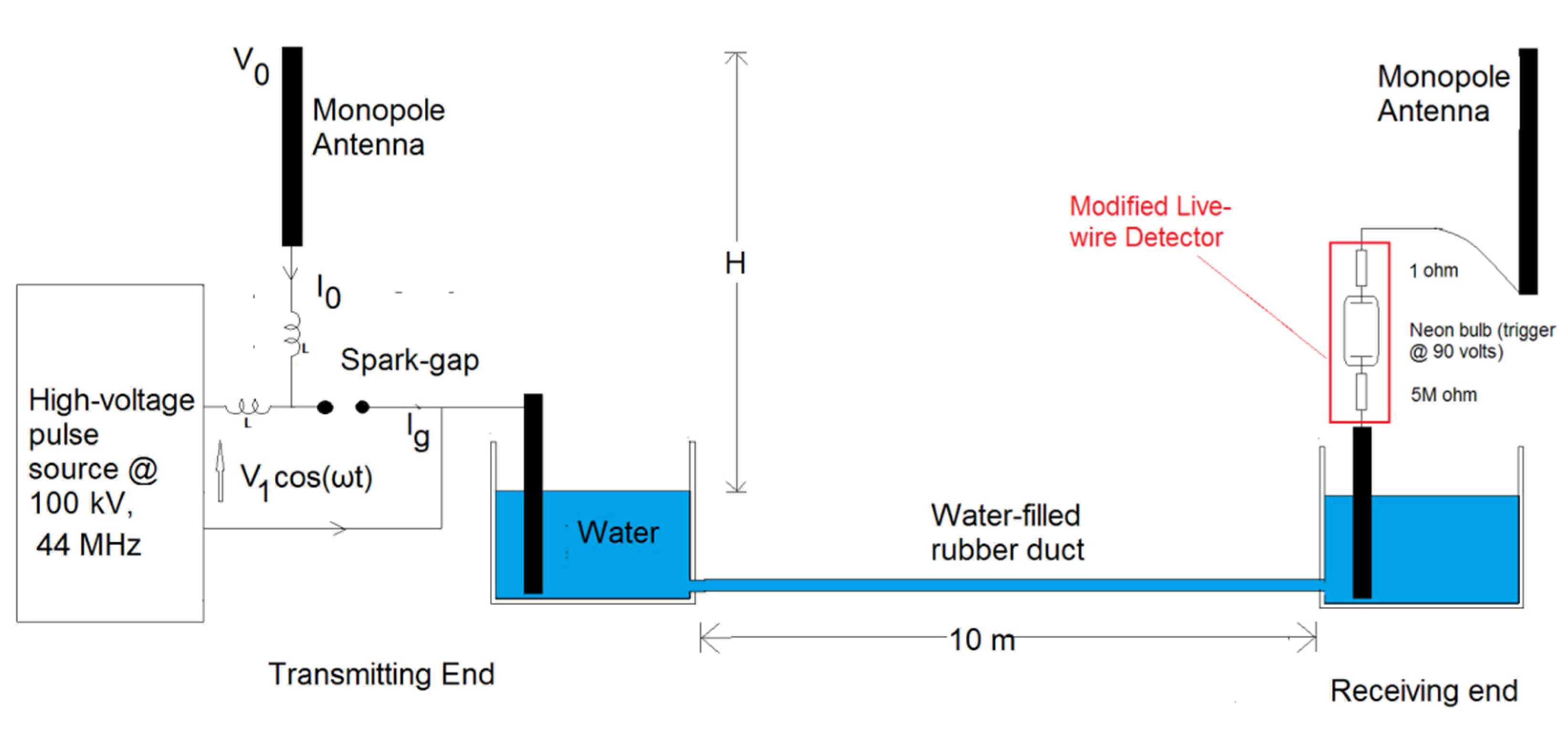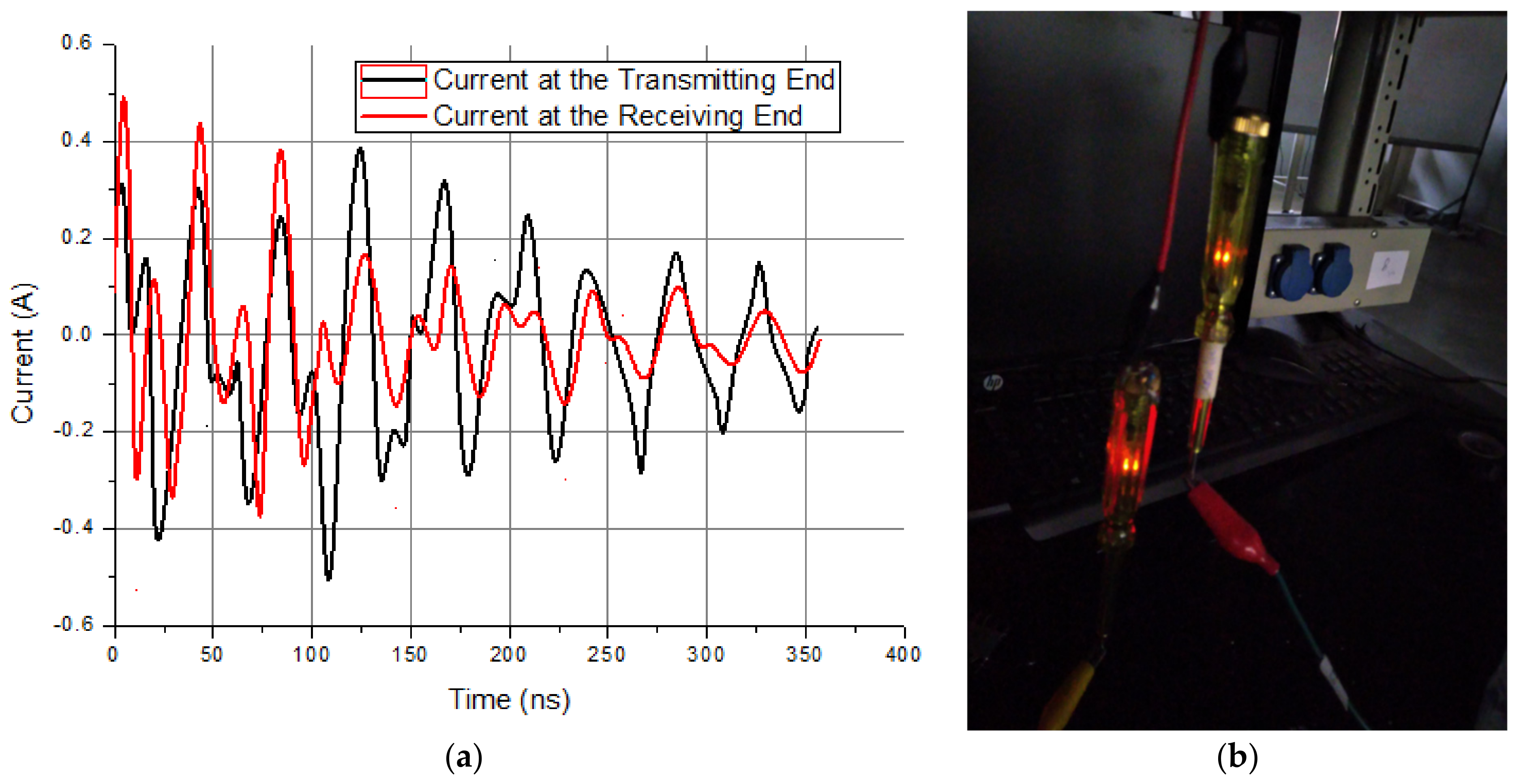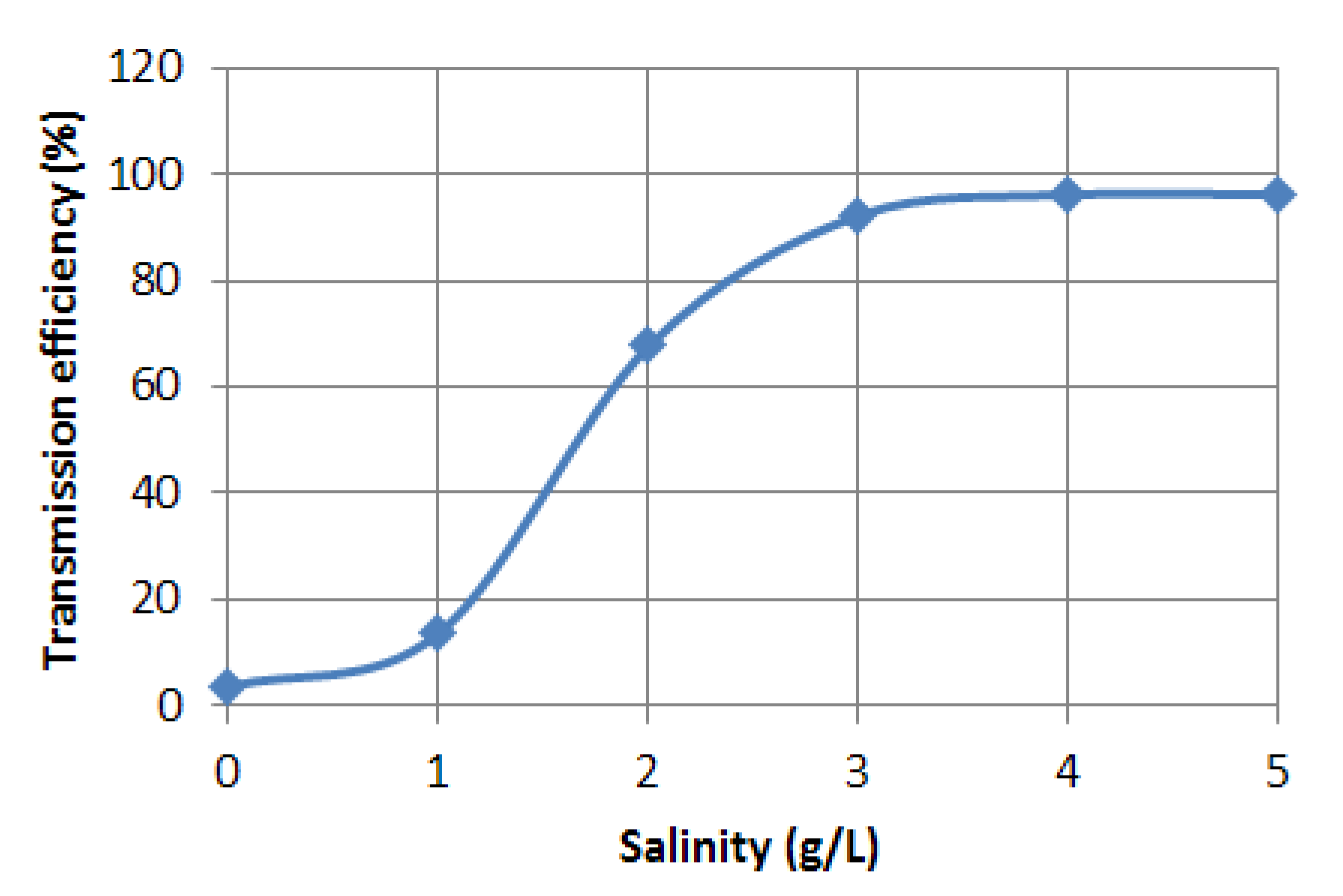Towards the Feasibility of Long Range Wireless Power Transfer over an Ocean Surface
Abstract
:1. Introduction
1.1. Use of Ground Waves
1.2. Use of Monopole Antennas
- (1)
- A high-voltage surface wave can be wirelessly transmitted along a curved or highly bent interface between a low-loss non-polar dielectric medium and a high-loss polar dielectric medium.
- (2)
- According to our findings, it is possible to deliver a wireless energy to multiple loads, if and only if each of the loads is connected to a vertically mounted monopole antenna which reaches a higher altitude.
- (3)
- Our experimental results reveal that the salinity level can enhance the transmission efficiency to a significant extent.
- (4)
- The correlation between the antenna height and the maximum transmission range is largely consistent with the Marconi’s law of transmission.
2. Methodology and Materials
2.1. Theory
2.2. Electromagnetic Simulation of Spoof Surface Plasma Waves on a Seawater Surface
2.3. Choice of Materials for Medium 2
2.4. Experimental Setup
2.4.1. Transmitting End
2.4.2. Receiving End
3. Results
- (a)
- Basic functionality test.
- (b)
- An experiment testing for the feasibility of wireless power delivery to the receiving end when a tap water was used.
- (c)
- An experiment testing other materials as medium 2.
- (d)
- An experiment testing for wireless transmission of power under different salinity levels.
- (e)
- Transmission efficiency vs. distance test under different antenna heights.
3.1. Basic Functionality Test
- (1)
- The voltage of input feeding the spark gap was sufficiently high, typically above 20 kV.
- (2)
- The top of the monopole antenna in the transmitting end reached an altitude of at least 1 m above the experimental setup.
- (3)
- The top of each of the live-wire detectors was connected to a vertically mounted monopole antenna as stated in (2).
3.2. Feasibility of Wireless Power Delivery to the Receiving End when a Tap Water Was Used
3.3. Wireless Power Transfer under Different Salinity Levels
3.4. Feasibility of Wireless Power Transfer when Non-Polar Solvents Were Used as Medium 2
3.5. Transmission Efficiency Versus Distance Test under Different Antenna Heights
4. Discussion
- (i)
- The transmitting end and the receiving end are connected to a vertically mounted long monopole antenna.
- (ii)
- The transmitting end is excited with a high-voltage spark gap transmitter.
- A high-voltage surface wave can be wirelessly transmitted along a curved or highly bent interface between a low-loss dielectric medium and a high-loss polar dielectric medium.
- Even though tap water has very little conductivity, the high-voltage surface electromagnetic wave can propagate along the surface of a tap water and be delivered to multiple loads at the expense of the transmission efficiency.
- It was possible to deliver a high-voltage surface electromagnetic wave to multiple loads, if and only if each of the loads is individually connected to a vertically mounted monopole antenna.
- The salinity level of the water can enhance the transmission efficiency to a significant extent.
- As a byproduct of this work, a live-wire detector can operate without any human contact if its metal top is connected to an antenna which reaches a great height or is suspended in mid-air.
- As a byproduct of this work, the results of this work can be used to test if a substance is polar or not.
- The transmission efficiencies as a function of the propagation distance have been measured under three different antenna heights. The measured results suggest that the correlation between the antenna height and the propagation distance in general obeys the Marconi’s law of transmission.
5. Conclusions
Author Contributions
Funding
Institutional Review Board Statement
Informed Consent Statement
Data Availability Statement
Conflicts of Interest
Appendix A

References
- Marconi, G. Wireless Telegraphic Communication; Nobel Lecture, December 11, 1909, Nobel Lectures, Physics 1901–1921; Elsevier: Amsterdam, The Netherlands, 1967. [Google Scholar]
- Marconi, G. The inventor of wireless telegraphy: A reply. Saturday Rev. 1902, 93, 556–557. [Google Scholar]
- Thompson, S.P. Wireless telegraphy: A rejoinder. Saturday Rev. 1902, 93, 598–599. [Google Scholar]
- Marconi, G. Wireless telegraphy. J. Inst. Elect. Eng. 1899, 28, 273–291. [Google Scholar]
- Bondyopadhyay, P.K. Guglielmo Marconi–The father of long distance radio communication, An engineer’s tribute. In Proceedings of the 25th European Microwave Conference, Bologna, Italy, 4–6 September 1995; pp. 879–885. [Google Scholar]
- Mazzinghi, P.; Pelosi, G. Enrico Fermi talks about Guglielmo Marconi [historical corner]. IEEE Antennas Propag. Mag. 2011, 53, 226–230. [Google Scholar] [CrossRef]
- Zenneck, J. Propagation of plane EM waves along a plane conducting surface. Annal. Phys. 1907, 28, 846–866. [Google Scholar] [CrossRef]
- Sommerfeld, A. Propagation of waves in wireless telegraphy. Annal. Phys. 1909, 28, 665–736. [Google Scholar] [CrossRef]
- Sommerfeld, A. Propagation of waves in wireless telegraphy. Annal. Phys. 1926, 81, 1135–1153. [Google Scholar] [CrossRef]
- Weyl, H. The propagation of electromagnetic waves over a plane conductor. Annal. Phys. 1919, 60, 481–500. [Google Scholar] [CrossRef]
- Van der Pol, B.; Niessen, K.F. Über die Ausbreitung elektromagnetischer Wellen über eine ebene Erde. Annal. Phys. 1930, 398, 273–294. [Google Scholar] [CrossRef]
- Wait, J.R. The ancient and modern history of EM ground-wave propagation. IEEE Antennas Propag. Mag. 1998, 40, 7–24. [Google Scholar] [CrossRef]
- Tamir, T.; Staiman, D. Nature and optimisation of the ground (lateral) wave excited by submerged antennas. Proc. IEEE 1966, 113, 1299–1310. [Google Scholar]
- Tesla, N. The True Wireless (Electrical Experimenter); Electrical Experimenter: New York, NY, USA, 1919. [Google Scholar]
- Liu, L.W.; Kandwal, A.; Eremenko, Z.E.; Zhang, Q. Open-ended voltage multipliers for wireless transmission of electric power. J. Microw. Power Electromagn. Energy 2017, 25, 187–204. [Google Scholar] [CrossRef]
- Tesla, N. The transmission of electrical energy without wires as a means for furthering peace. Elect. World Eng. 1905, 1, 21–24. [Google Scholar]
- Collin, R.E. Some observations about the near zone electric field of a hertzian dipole above a lossy earth. IEEE Trans. Antennas Propag. 2004, 52, 3133–3137. [Google Scholar] [CrossRef]
- Collin, R.E. Hertzian dipole radiating over a lossy earth or sea: Some early and late 20th-century controversies. IEEE Antennas Propag. Mag. 2004, 46, 64–79. [Google Scholar] [CrossRef]
- Petrillo, L.; Jangal, F.; Darces, M.; Montmagnon, J.-L.; H’elier, M. Negative permittivity Media Able to Propagate a Surface Wave. Prog. Electromagn. Res. 2011, 115, 1–10. [Google Scholar] [CrossRef]
- Liu, L.W.; Kandwal, A.; Shi, H.; Cheng, Q.S. Wireless Power Transfer using An RF Plasma. IEEE Access 2018, 6, 73905–73915. [Google Scholar] [CrossRef]
- Collin, R.E. Field Theory of Guided Waves; Chapter 11 Surface Waveguides; Wiley-IEEE Press: New York, NY, USA, 1990. [Google Scholar]
- Liu, L.W.; Zhang, Q.; Chen, Y.; Teeti, M.A.; Das, R. Wireless Energy Harvesting by Direct Voltage Multiplication on Lateral Waves From a Suspended Dielectric Layer. IEEE Access 2017, 5, 21873–21884. [Google Scholar] [CrossRef]
- Derrien, T.J.; Krüger, J.; Bonse, J. Properties of surface plasmon polaritons on lossy materials: Lifetimes, periods and excitation conditions. J. Opt. 2016, 18, 115007. [Google Scholar] [CrossRef]
- Tang, W.X.; Zhang, H.C.; Ma, H.F.; Jiang, W.X.; Cui, T.J. Concept, Theory, Design, and Applications of Spoof Surface Plasmon Polaritons at Microwave Frequencies. Adv. Opt. Mater. 2019, 7, 1800421. [Google Scholar] [CrossRef]
- Paloma Arroyo, H.; Fernández-Domínguez, A.I.; John, B.P.; Martín-Moreno, L.; Garcia-Vidal, F.J. Spoof Surface Plasmon Metamaterials; Cambridge University Press: Cambridge, UK, 2018; ISBN 9781108553445. [Google Scholar] [CrossRef]
- Fitzpatrick, R. Dielectric Constant of a Plasma. 2022. Available online: https://farside.ph.utexas.edu/teaching/em/lectures/node100.html (accessed on 6 May 2022).
- Calzada, M.D.; Moisan, M.; Gamero, A.; Sola, A. Experimental investigation and characterization of the departure from local thermodynamic equilibrium along a surface wave sustained discharge at atmospheric pressure. J. Appl. Phys. 1996, 80, 46. [Google Scholar] [CrossRef]
- Nhan, T.T.; Theu, L.T.; Tuan, L.; Viet, N.A. Drude-jellium model for the microwave conductivity of electrolyte solutions. J. Phys. Conf. Ser. 2018, 1034, 012006. [Google Scholar] [CrossRef]
- Shilov, I.Y.; Lyashchenko, A.K. The Role of Concentration Dependent Static Permittivity of Electrolyte Solutions in the Debye−Hückel Theory. J. Phys. Chem. B 2015, 119, 10087–10095. [Google Scholar] [CrossRef]
- Li, S.; Li, S.; Anwar, S.; Tian, F.; Lu, W.; Hou, B. Determination of Microwave Conductivity of Electrolyte Solutions from Debye-Drude Model. In Proceedings of the Progress in Electromagnetics Research Symposium, Guangzhou, China, 25–28 August 2014. [Google Scholar]
- Salem, A.A.; Lau, K.Y.; Abdul-Malek, Z.; Zhou, W.; Al-Ameri, S.; Al-Gailani, S.A.; Rahman, R.A. Investigation of High Voltage Polymeric Insulators Performance under Wet Pollution. Polymers 2022, 14, 1236. [Google Scholar] [CrossRef] [PubMed]
- Raymond, R. Re: What Is the Effect of High Voltage on Dielectric Materials? 2014. Available online: https://www.researchgate.net/post/What-is-the-effect-of-high-voltage-on-dielectric-materials/53a03be5d4c11862098b4729/citation/download (accessed on 6 May 2022).
- Wu, K.; Okamoto, T.; Suzuoki, Y. Effects of discharge area and surface conductivity on partial discharge behavior in voids under square voltages. IEEE Trans. Dielectr. Electr. Insul. 2007, 14, 461–470. [Google Scholar] [CrossRef]
- Lasabi, O.A. Performance of Insulators under HVDC Stress. Ph.D. Thesis, University of Kwazulu-Natal, Durban, South Africa, August 2018. [Google Scholar]
- Browne, T.E., Jr. Circuit Interruption: Theory and Techniques; Marcel Dekker, Inc.: New York, NY, USA, 1984. [Google Scholar]
- Unknown Editor. Microwaves101.com. Available online: https://www.microwaves101.com/encyclopedias/skin-depth (accessed on 14 June 2022).
- Liu, L.W.Y.; Zhang, Q.; Chen, Y. Harvesting atmospheric ions using surface electromagnetic wave technologies. J. Adv. Technol. Innov. 2017, 2, 99104. [Google Scholar]
- Chalmers, J.A. Atmospheric Electricity; Pergamon Press: London, UK, 1957. [Google Scholar]
- Brenni, P. Prometheus’ Tools: Instruments and Apparatus Used in Atmospheric Electricity Research and Experiments. Trans. Am. Philos. Soc. 2009, 99, 230–255. [Google Scholar]
- Kandwal, A.; Nie, Z.; Igbe, T.; Li, J.; Liu, Y.; Liu, L.W.; Hao, Y. Surface Plasmonic Feature Microwave Sensor With Highly Confined Fields for Aqueous-Glucose and Blood-Glucose Measurements. IEEE Trans. Instrum. Meas. 2021, 70, 1–9. [Google Scholar] [CrossRef]
- Kittel, C. Introduction to Solid State Physics, 6th ed.; John Wiley: New York, NY, USA, 1986. [Google Scholar]
- Nomura, S.; Kageura, M.; Toyota, H.; Mukasa, S. G0601-5-3 Discharge Characteristics of High-Frequency In-Liquid Plasma. Proc. JSME Annu. Meet. 2009, 3, 49–50. [Google Scholar] [CrossRef]
- Oruganti, S.K.; Liu, F.; Paul, D.; Liu, J.; Malik, J.; Feng, K.; Kim, H.; Liang, Y.; Thundat, T.; Bien, F. Experimental Realization of Zenneck Type Wave-based Non-Radiative, Non-Coupled Wireless Power Transmission. Sci. Rep. 2020, 10, 925. [Google Scholar] [CrossRef] [Green Version]





| Polarity of the Substance | Detection of Power When the Modified Live-Wire Detector Was in Contact with Medium 2 | Detection Near-Field Magnetic Coupling | Transmission Range between the Detection Point and the Excitation Source | |
|---|---|---|---|---|
| Oil | Non-polar | No | None | 5 cm |
| Oil Mixed with Detergent | Polar | Yes | None | 1 m |
| Coating of a Current-Carrying Electric Cable | Polar | Yes | None | 1 m |
| Antenna Height (m) | Estimated Maximum Propagation Distance (m) | Maximum Signaling Distance (m) Based on Marconi’s Law of Transmission |
|---|---|---|
| 1 | 2.5 | 2.5 |
| 1.6 | 7.5 | 6.4 |
| 2 | 10 | 10 |
Publisher’s Note: MDPI stays neutral with regard to jurisdictional claims in published maps and institutional affiliations. |
© 2022 by the authors. Licensee MDPI, Basel, Switzerland. This article is an open access article distributed under the terms and conditions of the Creative Commons Attribution (CC BY) license (https://creativecommons.org/licenses/by/4.0/).
Share and Cite
Liu, L.W.Y.; Thành, S.N. Towards the Feasibility of Long Range Wireless Power Transfer over an Ocean Surface. Appl. Sci. 2022, 12, 8751. https://doi.org/10.3390/app12178751
Liu LWY, Thành SN. Towards the Feasibility of Long Range Wireless Power Transfer over an Ocean Surface. Applied Sciences. 2022; 12(17):8751. https://doi.org/10.3390/app12178751
Chicago/Turabian StyleLiu, Louis W. Y., and Sơn Nguyễn Thành. 2022. "Towards the Feasibility of Long Range Wireless Power Transfer over an Ocean Surface" Applied Sciences 12, no. 17: 8751. https://doi.org/10.3390/app12178751
APA StyleLiu, L. W. Y., & Thành, S. N. (2022). Towards the Feasibility of Long Range Wireless Power Transfer over an Ocean Surface. Applied Sciences, 12(17), 8751. https://doi.org/10.3390/app12178751






